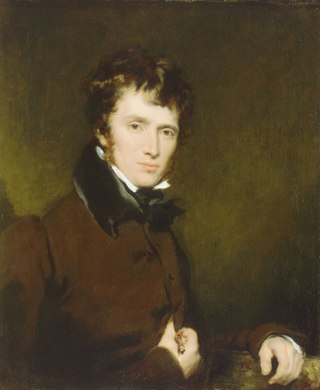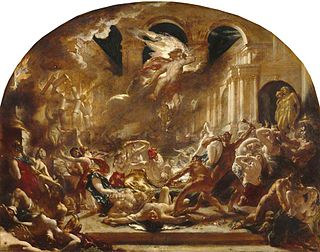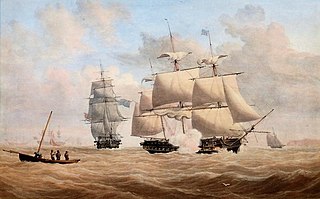
Highgate Cemetery is a place of burial in north London, England. There are approximately 170,000 people buried in around 53,000 graves across the West and East Cemeteries. Highgate Cemetery is notable both for some of the people buried there as well as for its de facto status as a nature reserve. The Cemetery is designated Grade I on the Register of Historic Parks and Gardens. It is one of the Magnificent Seven cemeteries in London.

John Maler Collier RP was a British painter and writer. He painted in the Pre-Raphaelite style, and was one of the most prominent portrait painters of his generation. Both of his marriages were to daughters of Thomas Henry Huxley. He was educated at Eton College, and he studied painting in Paris with Jean-Paul Laurens and at the Munich Academy starting in 1875.

Clarkson Frederick Stanfield was a prominent English painter who was best known for his large-scale paintings of dramatic marine subjects and landscapes. He was the father of the painter George Clarkson Stanfield and the composer Francis Stanfield.

James Duffield Harding was a British landscape painter, lithographer and author of drawing manuals. His use of tinted papers and opaque paints in watercolour proved influential.

Jacques Joseph Tissot, better known as James Tissot, was a French painter, illustrator, and caricaturist. He was born to a drapery merchant and a milliner and decided to pursue a career in art at a young age, coming to incorporate elements of realism, early Impressionism, and academic art into his work. He is best known for a variety of genre paintings of contemporary European high society produced during the peak of his career, which focused on the people and women's fashion of the Belle Époque and Victorian England, but would also explore many Medieval, Biblical, and Japoniste subjects throughout his life. His career included work as a caricaturist for Vanity Fair under the pseudonym of Coïdé.
Winsor & Newton is an English manufacturing company based in London that produces a wide variety of fine art products, including acrylics, oils, watercolour, gouache, brushes, canvases, papers, inks, graphite and coloured pencils, markers, and charcoals.

Henry Inman was an American portrait, genre, and landscape painter.
Richard Buckner Gruelle was an American Impressionist painter, illustrator, and author, who is best known as one of the five Hoosier Group artists. Gruelle's masterwork is The Canal—Morning Effect (1894), a painting of the Indianapolis, Indiana skyline, but he is also known for his watercolors and marine landscapes of the Gloucester, Massachusetts, area. In 1891 Indiana poet James Whitcomb Riley commissioned Gruelle to illustrate two of his more notable poems, "When the Frost is on the Punkin'" and "The Old Swimmin' Hole," which were published in Neighborly Poems (1891). Gruelle is also the author of Notes, Critical and Biographical: Collection of W. T. Walters (1895), which provides a detailed description of Baltimore industrialist William Thompson Walters's extensive art collection.

Otto Stark was an American Impressionist painter muralist, commercial artist, printmaker, and illustrator from Indianapolis, Indiana, who is best known as one of the five Hoosier Group artists. Stark's work clearly showed the influence of Impressionism, and he often featured children in his work. To provide a sufficient income for his family, Stark worked full time as supervisor of art at Emmerich Manual High School in Indianapolis from 1899 to his retirement in 1919, and as part-time art instructor on the faculty of the John Herron Art Institute from 1905 to 1919. Stark frequently exhibited his paintings at international, national, regional, and local exhibitions, including the Paris Salon of 1886 and 1887; the Five Hoosier Painters exhibition (1894) in Chicago, Illinois; the Trans-Mississippi Exposition (1898) in Omaha, Nebraska; the Louisiana Purchase Exposition (1904) in Saint Louis, Missouri; and international expositions (1910) in Buenos Aires, Argentina, and Santiago, Chile. He also supervised the Indiana exhibition at the Panama-Pacific International Exhibition (1915) in San Francisco, California. Stark remained an active artist and member of the Indianapolis arts community until his death in 1926.
Liquin is a quick-drying medium for oil and alkyd paint. Used as an additive in many forms of artwork, Liquin is produced by Winsor & Newton and has a number of uses.

White lead is the basic lead carbonate 2PbCO3·Pb(OH)2. It is a complex salt, containing both carbonate and hydroxide ions. White lead occurs naturally as a mineral, in which context it is known as hydrocerussite, a hydrate of cerussite. It was formerly used as an ingredient for lead paint and a cosmetic called Venetian ceruse, because of its opacity and the satiny smooth mixture it made with dryable oils. However, it tended to cause lead poisoning, and its use has been banned in most countries.
Henry Newton may refer to:
William Henry Osborn was an American businessman and philanthropist. He was a railroad tycoon who, as head of the Illinois Central Railroad and later the Chicago, St. Louis and New Orleans Railroad, became one of the most prominent railroad leaders in the United States. A friend and patron of the painter Frederic Edwin Church, he was an avid art collector. His two sons went on to become presidents of prominent museums in New York City.

Reeves and Sons is an English art materials brand and a former manufacturing company established by William Reeves (1739–1803) in 1766. Reeves is credited with having invented the soluble watercolour.

Thomas Le Clear was an American painter.
Robert Clarke & Company was a book publishing company and bookseller in Cincinnati, Ohio, from 1858 to 1909. After 1894, it was known as The Robert Clarke Company. It published literary and historical works.

The Destroying Angel and Daemons of Evil Interrupting the Orgies of the Vicious and Intemperate, also known as The Destroying Angel and Daemons Inflicting Divine Vengeance on the Wicked and Intemperate and as The Destruction of the Temple of Vice, is an 1832 English oil painting on canvas by English artist William Etty, first exhibited in 1832. Etty had become famous for nude paintings, and acquired a reputation for tastelessness, indecency and a lack of creativity. With The Destroying Angel he hoped to disprove his critics with an openly moral piece. The painting is 127.8 cm by 101.9 cm and depicts a classical temple under attack from a destroying angel and a group of daemons. Some of the humans appear dead or unconscious, others flee or struggle against the daemons.
Colart, or the Colart Group, is a large international supplier of art materials, with subsidiaries and brands such as Winsor & Newton, Liquitex and Lefranc & Bourgeois. The group's head office is situated in London.

General George Washington at Trenton is a large full-length portrait in oil painted in 1792 by the American artist John Trumbull of General George Washington at Trenton, New Jersey, on the night of January 2, 1777, during the American Revolutionary War. This is the night after the Battle of the Assunpink Creek, also known as the Second Battle of Trenton, and before the decisive victory at the Battle of Princeton the next day. The artist considered this portrait "the best certainly of those which I painted." The portrait is on view at the Yale University Art Gallery in New Haven, Connecticut, an 1806 gift of the Society of the Cincinnati in Connecticut. It was commissioned by the city of Charleston, South Carolina, but was rejected by the city, resulting in Trumbull painting another version.

The brothers John Cantiloe Joy, and William Joy, were English marine artists, who lived and worked together. They belonged to the Norwich School of painters, considered to be a unique phenomenon in the history of British art and the most important school of painting of 19th century England.













